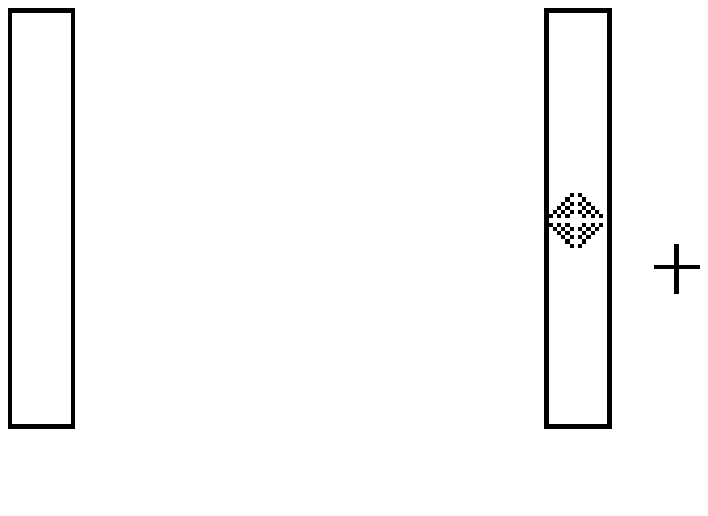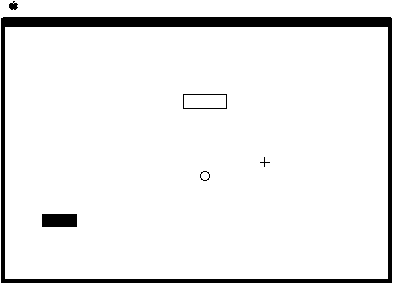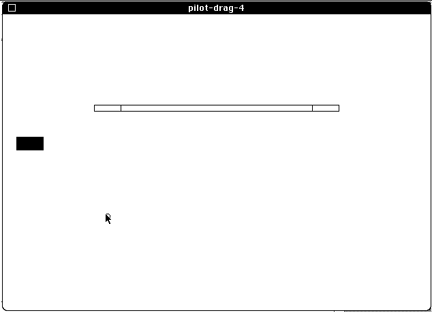5. METHODOLOGY
5.1 Hypotheses
The research questions presented informally in Chapters 2 and 3 (see pp. 19, 22, 29, 30, 39, & 42) are recast below as formal hypotheses underlying the present research. The order coincides with the earlier discussions.
| H1: | Correlation between MT and ID is independent of model (Fitts, Welford, or Shannon) for index of difficulty |
| H2: | Correlation between MT and ID is the same using ID calculated from the effective target width (in 1-D or 2-D) rather than the specified target width |
| H3: | MT is independent of approach angle |
| H4: | Error rate is independent of approach angle |
| H5: | Correlation between MT and ID is independent of several methods of calculating W in the index of difficulty |
| H6: | Movement time is independent of device or task |
| H7: | Error rate is independent of device or task |
| H8: | Index of performance is independent of device or task |
| H9: | Point-drag-select tasks can be modeled as two separate Fitts' law tasks |
Hypotheses H1, H2, H6, H7, and H8 will be tested in the first experiment, H3, H4, and H5 in the second experiment, and H9 in the third. If the hypotheses were ranked by importance, H1 and H5 would stand out. The main contributions in this research lie in extending the theoretical and empirical arguments for the Shannon formulation over the Fitts' formulation (H1), and in introducing a useful technique for extending Fitts' law to two dimensional target acquisition tasks (H5). H1 has already been tested in the re-analysis of data from experiments by Fitts and others. Although the analyses provide evidence to reject the hypothesis (with the Shannon formulation out-performing the Fitts formulation), Experiment 1 is an attempt to provide first-hand empirical evidence.
The extension of Fitts' law to dragging tasks (H6-H9) is important in light of the current genre of direct manipulation interfaces employing a variety of State 1 (pointing) and State 2 (dragging) transactions. Testing for device differences across tasks is important to aid in the design of direct manipulation systems employing pointing and dragging operations. H9, tested in Experiment 3, is the weakest hypotheses in a statistical sense since rejecting a null hypothesis is not the basis of the analysis. Demonstration is the main objective. When a State 2 action follows a State 1 action (as commonly occurs), it is claimed that the effect is that of two Fitts' law tasks in sequence. Two prediction equations should apply, reflecting the inherent information processing capacities in each task.
5.2 Experiment 1
In Fitts' original experiment, subjects moved a stylus back and forth between two targets and tapped on them as quickly and accurately as possible (see Figure 1). Experiment 1 mimicked Fitts' paradigm except subjects manipulated an input device to move a cursor between two targets displayed on a CRT display.
5.2.1 Subjects
Twelve male students in a computer engineering technology programme at a local college volunteered as subjects and were paid an hourly rate. All subjects used computers on a daily basis. Experience with input devices (other than a keyboard) was minimal.
5.2.2 Apparatus
An Apple Macintosh II microcomputer (running system software version 6.0.4) served as the host computer with input through a mouse (standard equipment), a trackball, and a pressure-sensing tablet-with-stylus. The output display was a 33 cm colour CRT monitor (used in black-and-white mode) with a resolution of 640 by 480 pixels. The trackball was a Turbo Mouse ADB Version 3.0 by Kensington Microware Ltd. Both the mouse and the trackball contained a momentary switch – a "button" – which was pressed and released to select targets.
The tablet, a Model SD42X by Wacom Inc., sensed pressure and absolute x-y coordinates using a stylus as input. The pressure of the stylus was sensed with 6 bits of resolution. Positioning was absolute: If the stylus was raised more than 1/4 inch above the tablet and then repositioned, the cursor jumped to the new x-y position when the stylus was re-engaged. If the stylus remained within 1/4 inch of the tablet, the cursor continued to track as the stylus moved.
The control-display gain for the tablet-with-stylus was matched to that for the mouse which in turn was set to .53 (equivalent to the "fast" setting in the Macintosh control panel).
Although the tablet-with-stylus had the potential for pseudo-analogue applications (with 6 bits of resolution), the present experiment used a threshold value set between 0 and 63 to signal a "select" operation. A threshold of 50 was chosen based on the subjective preferences of experienced users.
5.2.3 Procedure
Subjects performed multiple trials on two different tasks using three different devices. The operation of the devices and the requirements of the tasks were explained and demonstrated to each subject before beginning. One warm-up block of trials was given prior to data collection.
The two tasks were "point-select" and "drag-select". For the point-select task, subjects moved the cursor back and forth between the targets and selected each target by pressing and releasing a button on the device (or applying and releasing pressure on the stylus). An arrow pointing up appeared just below the target to be selected. After each selection, the arrow moved to the opposite target, thereby guiding subjects through the block of trials (see Figure 14a). Further feedback was provided by a black rectangle which appeared across the top of the display while in State 2. This feedback was particularly important with the stylus to inform subjects of a state change.
(a) (b)
Figure 14. Sample conditions for Experiment 1 showing (a) the point-select task and (b) the drag-select task
For the drag-select task, subjects acquired a small diamond-shaped object located in the centre of the target region by pressing and holding the device button, and then moved – that is, "dragged" – the object to the other target and deposited the object in the target region by releasing the button (see Figure 14b).
Subjects were instructed to balance the speed and accuracy of their moves to achieve an error rate around 4%. They were told that if too many errors were made, they were moving too fast, and if they never (or rarely) made an error, they weren't moving fast enough.
5.2.4 Design
A 3 × 2 × 4 × 4 fully within-subjects repeated measures design was used. Controlled variables were device (three levels), task (two levels), target amplitude (four levels), and target width (four levels). Dependent variables were movement time (MT ), error rate (calculated from the selection coordinates), and the index of performance (IP = MT / ID ). Movement time was measured from the beginning of a move to the button-down action in the pointing task or to the button-up action in the dragging task. The beginning of a move occurred for the pointing task on the button-up action at the end of the previous move, or for the dragging task on the button-down action when the object was acquired.
The experiment was sequenced by trials, blocks, sessions, and sittings. Each trail was a single point-select or drag-select task; each block was a series of 10 trials; each session was a series of 16 blocks covering, in random order, the 16 combinations of target amplitude and target width; each sitting was a series of 10 sessions alternating between blocks of the point-select and drag-select tasks. Sittings were conducted on three consecutive days using a different device each day. The order of administering devices was counterbalanced by groups of 3 subjects. The first task given in each session was determined by the toss of a coin and tasks alternated thereafter. After five sessions for all device/task combinations, a subject had completed a total of 10 × 4 × 4 × 2 × 3 × 5 = 4,800 trials.
Fitts' original experiments used four levels for target amplitude and target width (A = 2, 4, 8, & 16 in.; W = 1/4, 1/2, 1, & 2 in.) resulting in IDs from 1 to 7 bits. The design was similar in the present experiment with A = 8, 16, 32, & 64 units and W = 1, 2, 4, & 8 units. Each unit was mapped into 8 pixels, so the target centres were 512 pixels (8.5 cm) apart under the condition A = 64.
5.3 Experiment 2
The back-and-forth movements in Experiment 1 were extremely simple and therefore free of many confounding factors introduced in more complex tasks. However, the reciprocal tapping task is quite remote from the tasks users engage in with computers. In particular, Fitts' one-dimensional task has a consistent approach angle of 0° relative to the horizontal axis, whereas targets are approached from many directions in interactive tasks on computers.
The purpose of Experiment 2 was to test the techniques proposed earlier to improve the model's prediction power when targets are approached from various angles.
5.3.1 Subjects
Nine male and three female students from the Computer Science, Electrical Engineering, and Physics departments of a local university served as paid volunteers. All subjects were frequent users of mouse devices on Macintosh microcomputers or Sun workstations. ("Frequent" implies, on average, a minimum usage of several hours/week for the previous year.)
5.3.2 Apparatus
An Apple Macintosh II microcomputer was used with the standard mouse for input. The control panel settings, system software, and display were the same as described for Experiment 1.
5.3.3 Procedure
Experiment 2 and Experiment 3 (see below) were conducted together. Subjects performed multiple trials using a single device (mouse) alternating between a block of point-select trials (Experiment 2) and point-drag-select trials (Experiment 3). The tasks were demonstrated prior to starting and a block of warm-up trials was administered prior to data collection.
For each trial, a small circle appeared near the centre of the CRT display, and a rectangular target appeared elsewhere on the display (see Figure 15). Subjects were instructed to manipulate the mouse and move the cursor inside the circle, then wait for a visual cue before beginning. The cue was a small, black rectangular bar which appeared on the left of the screen and expanded in size for about 1 second. After the bar stabilized, a move could begin. Subjects could take as long as necessary to prepare for each move, but were told to move as quickly and accurately as possible once the cursor left the circle. Timing began when the cursor left the circle. The goal was to move to the target (as quickly and accurately as possible) and select the target by pressing and releasing the mouse button.
Figure 15. Sample condition for Experiment 2
If a move started before the bar stabilized, a beep was heard and the subject had to reposition the cursor inside the circle and restart the move. The same instructions for speed vs. accuracy as in Experiment 1 were given.
5.3.4 Design
A fully-within subjects repeated measures design was used. Controlled variables were approach angle (θA = 0°, 45°, & 90°), target amplitude (A = 2, 4, 8, 16, & 32 units), target width (W = 1, 2, 4, & 8 units), and target height (H = 1, 2, 4, & 8 units). Each unit was mapped into 10 pixels; thus the largest amplitude translated into 320 pixels (5.3 cm). Dependent variables were movement time (MT ) and error rate (calculated from the x and y coordinates of the selection).
Only 78 of 240 possible cells were used. This kept the experiment manageable and exhausted a wide and important range of test conditions. Twenty-six distance/size conditions (see Table 7) were crossed with the three approach angles. Conditions with W = H (viz., squares) were excluded since they yield only small differences in IDs among the various models tested. Amplitudes were selected in power-of-four increments starting at the larger of W or H. The latter requirement ensured that the starting position was outside the target for all approach angles.
Distance/size Conditions for Experiment 2
| Width | Height | Amplitude a | Combinations | ||||
|---|---|---|---|---|---|---|---|
| 2 | 4 | 8 | 16 | 32 | |||
| 2 | 1 | * | . | * | . | * | 3 |
| 4 | 1 | . | * | . | * | . | 2 |
| 8 | 1 | . | . | * | . | * | 2 |
| 1 | 2 | * | . | * | . | * | 3 |
| 4 | 2 | . | * | . | * | . | 2 |
| 8 | 2 | . | . | * | . | * | 2 |
| 1 | 4 | . | * | . | * | . | 2 |
| 2 | 4 | . | * | . | * | . | 2 |
| 8 | 4 | . | . | * | . | * | 2 |
| 1 | 8 | . | . | * | . | * | 2 |
| 2 | 8 | . | . | * | . | * | 2 |
| 4 | 8 | . | . | * | . | * | 2 |
| Total | 26 | ||||||
| a * = condition used; . = condition not used | |||||||
The 78 conditions were presented in random order until all conditions were exhausted. This constituted one block. Fifteen blocks were administered over four days (3 + 4 + 4 + 4) for a total of 1170 trials per subject.
5.4 Experiment 3
Experiment 3 combined the point-select and drag-select tasks of Experiment 1 in a compound discrete task similar to tasks found in direct manipulation interfaces. The main purpose was to demonstrate that a drag-select task following a point-select task can be modeled as two sequential Fitts' law tasks.
5.4.1 Subjects
See Experiment 2.
5.4.2 Apparatus
See Experiment 2.
5.4.3 Procedure
The procedure was similar to that for Experiment 2 except a point-drag-select task was used. Blocks of trials for Experiment 3 were interspersed with those of Experiment 2. Subjects moved the cursor to a target, acquired it by depressing the mouse button, then dragged the target to a destination target. The procedure resembled the operation of a scroll bar on the Macintosh (see Figure 16).
Figure 16. Sample condition for Experiment 3
5.4.4 Design
A fully within-subjects repeated measures design was used. Controlled variables were approach angle (θA = 0°, 45°, & 90°), point amplitude (A1 = 2, 4, 8, 16, & 32 units), drag amplitude (A2 = 2, 4, 8, 16, & 32 units), target width (W = 1, 2, 4, & 8 units), and target height (H = 1 & 2 units). One experiment unit was mapped into 10 pixels. The greatest horizontal distance covered was 480 pixels (8.0 cm), corresponding to A1 = 16 units, A2 = 32 units, and θA = 0°. Dependent variables were movement time (MT ) and error rate (calculated from the x and y coordinates of the selection) easurements were taken separately for the pointing and dragging components of each move.
Only 102 of 600 possible cells were used to keep the experiment manageable and to exhaust a wide and relevant range of test conditions. Thirty-four distance/size conditions (see Table 8) were crossed with the three approach angles. Point amplitudes were selected as in Experiment 2. Drag amplitudes were selected in power-of-four increments starting at 2 × W. This provided at least W units of separation between the pick-up and drop regions for dragging.
Distance/size Conditions for Experiment 3
| Width | Height | Point Amplitude a | Drag Amplitude a | Combinations | ||||||||
|---|---|---|---|---|---|---|---|---|---|---|---|---|
| 2 | 4 | 8 | 16 | 32 | 2 | 4 | 8 | 16 | 32 | |||
| 1 | 2 | x | . | x | . | x | x | . | x | . | . | 6 |
| 2 | 2 | x | . | x | . | x | . | x | . | x | . | 6 |
| 4 | 2 | . | x | . | x | . | . | . | x | . | x | 4 |
| 8 | 2 | . | . | x | . | x | . | . | . | x | . | 2 |
| 1 | 4 | . | x | . | x | . | x | . | x | . | x | 6 |
| 2 | 4 | . | x | . | x | . | . | x | . | x | . | 4 |
| 4 | 4 | . | x | . | x | . | . | . | x | . | x | 4 |
| 8 | 4 | . | . | x | . | x | . | . | . | x | . | 2 |
| Total | 34 | |||||||||||
| a x = used; . = not used (Note: point and drag conditions crossed) | ||||||||||||
The 102 conditions were presented in random order until all conditions were exhausted. This constituted one block. A total of 15 blocks were administered over four days for a total of 1530 trials per subject.


